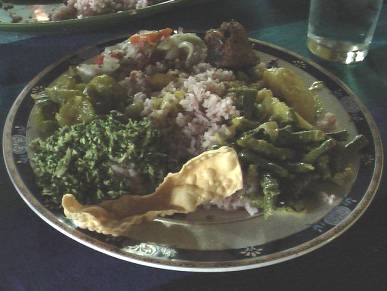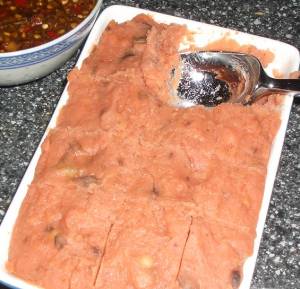Maeve O’Meara explores the colorful fresh flavors and seductive charm of Sri Lankan cooking. Maeve visits a fragrant spice emporium with top Australian Sri Lankan chef Peter Kuruvita from Flying Fish restaurant who hones in on the essentials. He whips up an elegant prawn curry with a creamy coconut sauce.
We meet caterer, food reviewer and tour guide Paul Van Reyk who demonstrates how to grate a fresh coconut and uses it to make a simple vibrant sambal with a touch of chilli and a delicious fresh green stir fry with a handful of ingredients. Maeve's chef friend Sunil Ranasinghe cooks up the most beautiful pumpkin curry thickened with toasted coconut and ground rice.
Australia's queen of Asian cooking Charmaine Solomon shows some shortcuts and tips on making a marvellous Sri Lankan chicken curry. She then shows Maeve how to eat Sri Lankan style—without knives and forks—using string hoppers to scoop up curry and accompaniments. We see how string hoppers and hoppers are made—both are made with rice flour—one looks like a little mat of fine noodles, the other like a bowl-shaped pancake, both adored by Sri Lankans.
Dessert is the easiest dinner party sweet you'll find—a dense spiced custard made with coconut milk and and palm sugar called watalappam, made to a family recipe by Deborah Solomon.
Click here for the recipes featured in this episode.
Sri Lankan Cuisine
 Sri Lanka, the beautiful spice island once known as Ceylon, is a rich melting pot of cuisines. It seems every nationality that has visited and traded over the years has left a mark on the cuisine—the Dutch, Portuguese, English, Arabs, Malays, Moors and Indians.
Sri Lanka, the beautiful spice island once known as Ceylon, is a rich melting pot of cuisines. It seems every nationality that has visited and traded over the years has left a mark on the cuisine—the Dutch, Portuguese, English, Arabs, Malays, Moors and Indians.
Sri Lankan cuisine mainly consists of boiled or steamed rice served with curry. This usually consists of a "main curry" of fish, chicken, beef, pork or mutton), as well as several other curries made with vegetable, lentils and even fruit curries.
Side-dishes include pickles, chutneys and sambals. The most famous of these is the coconut sambal, made of ground coconut mixed with chillies, dried Maldive fish and lime juice. This is ground to a paste and eaten with rice, as it gives zest to the meal and is believed to increase appetite.
Another well-known rice dish is Kiribath, meaning "milk rice." In addition to sambals, Sri Lankans eat mallung, chopped leaves mixed with grated coconut and red onions. Coconut milk is found in most Sri Lankan dishes to give the cuisine its unique flavor.
Hoppers are another food native to Sri Lanka, served mainly for breakfast or dinner and often accompanied by Lunu miris, a mix of red onions and spices. Hoppers are made from a fermented batter of rice flour, coconut milk and a dash of palm toddy, which lends a sour flavor and fermentation ability. If toddy is not available, yeast is often used. The batter is left to rise, then cooked in a hemispherical wok-like pan. There are many types of hoppers including egg hoppers, milk hoppers,string hoppers, and sweeter varieties like vandu appa and pani appa.
Roti in Sri Lanka may be the Paratha or the chapati type of flatbread. Kottu Roti is a Sri Lankan dish, made from a Sri Lankan type of bread called Godamba Roti, and vegetables, egg, or meat, and various spices. An optional spicy gravy is usually served with a kottu roti. A hot kottu is generally eaten as a dinner meal. The common varieties include beef and chicken as well as egg and vegetable kottus made for vegetarians.
Spices:
Sri Lankan people use spices liberally in their dishes and typically do not follow an exact recipe: thus, every cook's curry will taste slightly different. Furthermore, people from different regions of the island (for instance, hill-country dwellers versus coastal dwellers) traditionally cook in different ways while people of different ethnic and religious groups tend to prepare dishes according to their customs. Although Sri Lankan food is similar to south Indian cuisine in its use of chilli, cardamom, cumin, coriander and other spices, it has a distinctive taste, and uses ingredients like dried Maldive fish which are local to the area.
The cuisine of Sri Lanka shares similarities with the cuisines of South India, however, Sri Lankan food is generally much spicier than most South Indian cuisine, and many spicy Sri Lankan preparations are believed to be among the world's hottest in terms of chilli content. There is a liberal use of different varieties of scorching hot chillies such as amu miris, kochchi miris, and maalu miris (capsicum) among others. While native Sri Lankans are born into this cuisine and develop a healthy tolerance to spicy food, many visitors and tourists to the country often find the spiciness excessive. As a result, many local restaurants in developed and tourist areas offer special low-spice versions of local foods to cater to foreign palates.
Sweets:
 Sri Lanka is one of the places in South Asia that is famous for its sweets and desserts, which are native to them. Mostly the desserts are served after the main meals and sweets are specially for the tea time. Most of these desserts and sweets have cultural background. A lot of desserts and sweets are rich in domestic spices, jaggery and kithul (Caryota urens) treacle. Traditionally, usage of sugar is minimum due to the availability of locally made alternatives such as treacle and jaggery.
Sri Lanka is one of the places in South Asia that is famous for its sweets and desserts, which are native to them. Mostly the desserts are served after the main meals and sweets are specially for the tea time. Most of these desserts and sweets have cultural background. A lot of desserts and sweets are rich in domestic spices, jaggery and kithul (Caryota urens) treacle. Traditionally, usage of sugar is minimum due to the availability of locally made alternatives such as treacle and jaggery.
A well-known sweet is Kavun or oil cakes, a cake made with rice flour and treacle and deep-fried to a golden brown. A variety of Kavun, called Moong Kavun is made from green gram (mung bean) which is then ground to a paste and shaped like diamonds before frying. Athirasa is yet another type of Kavun. It is a sweet-cake of jaggery and rice flour made into a paste flattened into circles and fried.
Beverages:
A very popular drink is Faluda, a mixed cold drink with syrup, ice cream, jelly pieces and basil seeds. Fruit juices are also popular in Sri Lanka, especially passionfruit juice.
A very popular alcoholic drink is the toddy, made from palm tree sap. Arrack is the de-facto distilled national drink.
Episodes:
 |
AFRICAN: Wherever you are in Africa, no meal is complete without a starchy porridge known as fufu. |
 |
BRAZILIAN: An exuberant, colorful mix of Portuguese, African and native foods including some from the Amazon. |
 |
CHINESE: Two thirds of households own a wok and use it regularly, but not everyone knows how to use it properly. |
 |
EGYPTIAN: Beans are used extensively and creatively as a source of protein, fibre, and comfort. |
 |
ENGLISH: "Meat & three veg" originated in the UK with dishes like roast beef, steak and kidney pie, and many more. |
 |
FRENCH: The French have elevated food into an art form. Nowhere else is so much attention paid to what people are going to eat and how. |
 |
HUNGARIAN: A fusion of simple peasant food & the elegant, highly developed cuisine from the days of the Austro Hungarian Empire. |
 |
INDIAN: A vibrant, intensely colorful cuisine. Each region of India has its own style of cooking and distinct flavors. |
 |
INDONESIAN: One of the most vibrant and colorful cuisines in the world, full of intense flavor and varied textures. |
 |
ITALIAN: An long-awaited introduction to the kitchens and restaurants of Australia’s top Italian chefs and home cooks. |
 |
JAPANESE: Refined and elegant, its preparation and presentation honed over the centuries so its flavors are pure and delicate. |
 |
JEWISH: While flavors of the Jewish palate are influenced by geography, the constant for Jews all over the world are the Kosher laws. |
 |
KOREAN: Some of the healthiest food on earth, with a near obsession with the fermented vegetable kimchi. |
 |
LEBANESE: Lebanese cuisine is generous and abundant, and this is some of the most exquisite food in the world. |
 |
MALTESE: The rocky island of Malta is home to some beautiful rustic recipes that sing of Mediterranean flavor and freshness. |
 |
MEXICAN: Authentic Mexican food is vibrant, spicy, delicious and fun. It varies according to which region its from. |
 |
MOROCCAN: One of the most cleverly balanced cuisines on earth; spices are used to enhance the flavor of dishes. |
 |
PAKISTANI: Full of marvelous and diverse dishes, it incorporates elements from its neighbors India, Afghanistan and Iran. |
 |
PERSIAN: From simple dips to hearty stews, food preparation is taken very seriously in Iran and is often a labor of love. |
 |
SOUTH AMERICAN: A fantastic fusion of culinary traditions from indigenous Indians, imported Africans, and the Spanish and Portuguese colonist. |
 |
SYRIAN: One of the highlights of Syrian food is mezza, a generous spread of small dishes and the prelude to even more food! |
 |
TURKISH: Nestled between Asia and Europe, Turkish food is an unique and exotic fusion with influences from many countries. |
Contact Us | Shop | Sitemap | Join Our Team | Investors | Advertise | Web Design Services
Community | Foodies' Choice | Meetup Groups | Chat | Blogs | Forums | Submit Your Site | Resources


